- Affiliate Program

- UNITED STATES
- 台灣 (TAIWAN)
- TÜRKIYE (TURKEY)
- Academic Editing Services
- - Research Paper
- - Journal Manuscript
- - Dissertation
- - College & University Assignments
- Admissions Editing Services
- - Application Essay
- - Personal Statement
- - Recommendation Letter
- - Cover Letter
- - CV/Resume
- Business Editing Services
- - Business Documents
- - Report & Brochure
- - Website & Blog
- Writer Editing Services
- - Script & Screenplay
- Our Editors
- Client Reviews
- Editing & Proofreading Prices
- Wordvice Points
- Partner Discount
- Plagiarism Checker
- APA Citation Generator
- MLA Citation Generator
- Chicago Citation Generator
- Vancouver Citation Generator
- - APA Style
- - MLA Style
- - Chicago Style
- - Vancouver Style
- Writing & Editing Guide
- Academic Resources
- Admissions Resources

How to Write an Academic Essay in 7 Simple Steps
What is an academic essay?
Academic essays are a common form of writing in higher education and play a crucial role in shaping a student’s future academic success. An academic essay is a piece of writing that presents an argument based on evidence and provides the reader with a clear and well-structured understanding of a particular subject. Writing an academic essay is not just about putting together a few words and sentences. It requires careful planning, research, and critical thinking skills to produce a well-written piece that meets the expectations of the reader.
In this article, we will explore the steps involved in writing an academic essay and provide you with tips and examples to help you create a top-quality piece of writing.
Step 1: Choose an Essay Topic
The first step in writing an academic essay is to choose a topic. A topic is the main idea or subject you will write about in your essay. Choose a topic that you are interested in and have a good understanding of. It should also be relevant to the course you are studying and the assignment you are working on.
While choosing the topic for your essay, be sure to follow the formatting requirements and other guidelines of your essay prompt. Read your assignment or prompt thorough and assess what is needed. For instance, if the guidelines call for your essay to follow a certain academic formatting style (such as MLA style , APA style , Chicago style , Vancouver style , etc.), this should be applied and reviewed during the editing process. As with any academic document, be sure to apply academic writing principles to your essay.
Some additional questions to ask before you begin drafting your essay:
- What is the specific question or questions that your essay needs to answer?
- Does your academic essay need to present a critical or rhetorical analysis of a source?
- Do you need to use primary and secondary sources ?
- Is the goal of the essay to present an original argument based on original research, or is it a review of the literature ?
- Do you need to compare two or more works for your analysis?
Step 2: Conduct Research
Once you have chosen a topic, it is time to conduct research. Research is essential for an academic essay as it provides you with the information you need to support your arguments. Use a variety of sources, including books, academic journals, online databases, and other reliable sources, to gather information about your topic.
There are several different types of research that you can use to gather information for your essay, including primary research, secondary research, and tertiary research.
Primary research involves collecting original data through surveys, interviews, or experiments. This type of research is often used to gather firsthand information about a specific topic and is particularly useful when secondary sources do not exist or are limited.
Secondary research involves using existing data and information that has been collected by someone else. This includes sources such as academic journals, books, and online databases. Secondary research is often the starting point for most essay research and provides a good foundation for your own original research.
Tertiary research involves using summary or overview sources, such as textbooks, encyclopedias, and reference books, to gather information about a topic. This type of research is often used to gain a general understanding of a subject or to find specific information quickly.
When conducting research, it is important to use a variety of sources to gather information and to critically evaluate the information you find. Make sure that your sources are credible and relevant to your topic and avoid using unreliable sources, such as personal blogs or opinion pieces. Take notes as you research and keep track of your sources, including the author, publication date, and page numbers, so that you can easily reference them later in your essay.
Step 3: Create an Essay Outline
An outline is a roadmap that guides you through the writing process and helps you stay organized. A good outline should include an introduction, body paragraphs, and a conclusion. Each body paragraph should include a topic sentence, supporting evidence, and a transition sentence that connects to the next paragraph. Just as an outline for a research paper presents the structure and a summary of each section of your study.
Essay outline template
This outline provides a basic structure for an essay and can be adjusted to fit the specific needs of your topic and assignment. The introduction sets the stage by providing a brief overview of the topic and a thesis statement that outlines the main argument of the essay.
The body of the essay includes three main points, each of which is supported by evidence and explained through analysis. The conclusion restates the thesis, summarizes the main points, and offers final thoughts and implications. This outline can be used as a starting point for organizing your ideas and ensuring that your essay is well-structured and well-supported.
Step 4: Write the Introduction
The introduction is the first part of your essay that the reader will read, so it is important to make a good impression. An essay introduction should provide background information on the topic, hook the reader’s attention, and present a thesis statement .
Here is an example of an introductory paragraph:
“The American Dream, once a symbol of hope and opportunity, has become increasingly elusive in recent years. Despite its origins as a means for individuals to pursue their own happiness and success, the American Dream has come to represent a set of unattainable goals that are beyond the reach of the average person. This essay will explore the ways in which the American Dream has become an unattainable goal for many Americans, including the reasons for its decline and the impact this has on society as a whole.”
This introduction provides context, raises a question, and presents a thesis statement all in under 200 words.
Step 5: Write the Body Paragraphs
The body paragraphs are where you develop your arguments and support them with evidence. Each paragraph should focus on one main idea and should include a topic sentence that introduces the idea, supporting evidence, and a transition sentence that connects to the next paragraph. Use transition words to connect paragraphs and provide a clearer structure to your arguments and overall essay.
Step 6: Write the Essay Conclusion
The essay conclusion is the final part of your essay and provides a summary of your main arguments. It should also restate your thesis statement and provide a final thought or call to action. The conclusion should leave a lasting impression on the reader and provide closure to your essay.
Here is an example of a conclusion paragraph for an academic essay about “The American Dream”:
“ In conclusion , the American Dream has undergone significant changes since its inception. Despite its original intention as a means for individuals to pursue their own happiness and success, the American Dream has come to represent an unattainable goal for many Americans. The factors contributing to this decline include economic inequality, declining social mobility, and a lack of access to education and job opportunities. This shift in the meaning of the American Dream has significant implications for society as a whole, including increased poverty and social unrest. In order to restore the American Dream to its original purpose, policymakers must address these systemic issues and work to create a more equitable society where all individuals have the opportunity to achieve their goals.”
Note the terms and phrases in bold that identify the conclusion paragraph and point to the main topics that are summarized.
Step 7: Revise and Edit Your Essay
Once you have completed the first draft of your essay, it is time to revise and edit. Review your essay for any mistakes, including grammatical errors , punctuation errors , spelling mistakes, and awkward sentence structure . Make sure that your essay is well-structured and that your arguments are well-supported with language that follows the conventions of academic writing and is appropriate for the essay assignment. To ensure your work is polished for style and free of errors, get essay editing from a professional proofreading company like Wordvice.
In conclusion, writing an academic essay is a process that requires careful planning, research, and critical thinking skills. By following the steps outlined in this article, you can write a top-quality essay that meets the expectations of the reader and earns you the grades you deserve. Remember to choose a topic that you are interested in and have a good understanding of, conduct research, create an outline, write a clear and concise introduction, develop well-supported body paragraphs, write a strong conclusion, and revise and edit your essay before submitting it.
How to Write an Academic Essay in 6 Simple Steps
#scribendiinc
Written by Scribendi
Are you wondering how to write an academic essay successfully? There are so many steps to writing an academic essay that it can be difficult to know where to start.
Here, we outline how to write an academic essay in 6 simple steps, from how to research for an academic essay to how to revise an essay and everything in between.
Our essay writing tips are designed to help you learn how to write an academic essay that is ready for publication (after academic editing and academic proofreading , of course!).
Your paper isn't complete until you've done all the needed proofreading. Make sure you leave time for it after the writing process!
Download Our Pocket Checklist for Academic Papers. Just input your email below!
Types of academic writing.
With academic essay writing, there are certain conventions that writers are expected to follow. As such, it's important to know the basics of academic writing before you begin writing your essay.
Read More: What Is Academic Writing?
Before you begin writing your essay, you need to know what type of essay you are writing. This will help you follow the correct structure, which will make academic paper editing a faster and simpler process.
Will you be writing a descriptive essay, an analytical essay, a persuasive essay, or a critical essay?
Read More: How to Master the 4 Types of Academic Writing
You can learn how to write academic essays by first mastering the four types of academic writing and then applying the correct rules to the appropriate type of essay writing.
Regardless of the type of essay you will be writing, all essays will include:
An introduction
At least three body paragraphs
A conclusion
A bibliography/reference list
To strengthen your essay writing skills, it can also help to learn how to research for an academic essay.

Step 1: Preparing to Write Your Essay
The essay writing process involves a few main stages:
Researching
As such, in learning how to write an academic essay, it is also important to learn how to research for an academic essay and how to revise an essay.
Read More: Online Research Tips for Students and Scholars
To beef up your research skills, remember these essay writing tips from the above article:
Learn how to identify reliable sources.
Understand the nuances of open access.
Discover free academic journals and research databases.
Manage your references.
Provide evidence for every claim so you can avoid plagiarism .
Read More: 17 Research Databases for Free Articles
You will want to do the research for your academic essay points, of course, but you will also want to research various journals for the publication of your paper.
Different journals have different guidelines and thus different requirements for writers. These can be related to style, formatting, and more.
Knowing these before you begin writing can save you a lot of time if you also want to learn how to revise an essay. If you ensure your paper meets the guidelines of the journal you want to publish in, you will not have to revise it again later for this purpose.
After the research stage, you can draft your thesis and introduction as well as outline the rest of your essay. This will put you in a good position to draft your body paragraphs and conclusion, craft your bibliography, and edit and proofread your paper.
Step 2: Writing the Essay Introduction and Thesis Statement
When learning how to write academic essays , learning how to write an introduction is key alongside learning how to research for an academic essay.
Your introduction should broadly introduce your topic. It will give an overview of your essay and the points that will be discussed. It is typically about 10% of the final word count of the text.
All introductions follow a general structure:
Topic statement
Thesis statement
Read More: How to Write an Introduction
Your topic statement should hook your reader, making them curious about your topic. They should want to learn more after reading this statement. To best hook your reader in academic essay writing, consider providing a fact, a bold statement, or an intriguing question.
The discussion about your topic in the middle of your introduction should include some background information about your topic in the academic sphere. Your scope should be limited enough that you can address the topic within the length of your paper but broad enough that the content is understood by the reader.
Your thesis statement should be incredibly specific and only one to two sentences long. Here is another essay writing tip: if you are able to locate an effective thesis early on, it will save you time during the academic editing process.
Read More: How to Write a Great Thesis Statement
Step 3: Writing the Essay Body
When learning how to write academic essays, you must learn how to write a good body paragraph. That's because your essay will be primarily made up of them!
The body paragraphs of your essay will develop the argument you outlined in your thesis. They will do this by providing your ideas on a topic backed up by evidence of specific points.
These paragraphs will typically take up about 80% of your essay. As a result, a good essay writing tip is to learn how to properly structure a paragraph.
Each paragraph consists of the following:
A topic sentence
Supporting sentences
A transition
Read More: How to Write a Paragraph
In learning how to revise an essay, you should keep in mind the organization of your paragraphs.
Your first paragraph should contain your strongest argument.
The secondary paragraphs should contain supporting arguments.
The last paragraph should contain your second-strongest argument.
Step 4: Writing the Essay Conclusion
Your essay conclusion is the final paragraph of your essay and primarily reminds your reader of your thesis. It also wraps up your essay and discusses your findings more generally.
The conclusion typically makes up about 10% of the text, like the introduction. It shows the reader that you have accomplished what you intended to at the outset of your essay.
Here are a couple more good essay writing tips for your conclusion:
Don't introduce any new ideas into your conclusion.
Don't undermine your argument with opposing ideas.
Read More: How to Write a Conclusion Paragraph in 3 Easy Steps
Now that you know how to write an academic essay, it's time to learn how to write a bibliography along with some academic editing and proofreading advice.
Step 5: Writing the Bibliography or Works Cited
The bibliography of your paper lists all the references you cited. It is typically alphabetized or numbered (depending on the style guide).
Read More: How to Write an Academic Essay with References
When learning how to write academic essays, you may notice that there are various style guides you may be required to use by a professor or journal, including unique or custom styles.
Some of the most common style guides include:
Chicago style
For help organizing your references for academic essay writing, consider a software manager. They can help you collect and format your references correctly and consistently, both quickly and with minimal effort.
Read More: 6 Reference Manager Software Solutions for Your Research
As you learn how to research for an academic essay most effectively, you may notice that a reference manager can also help make academic paper editing easier.

Step 6: Revising Your Essay
Once you've finally drafted your entire essay . . . you're still not done!
That's because editing and proofreading are the essential final steps of any writing process .
An academic editor can help you identify core issues with your writing , including its structure, its flow, its clarity, and its overall readability. They can give you substantive feedback and essay writing tips to improve your document. Therefore, it's a good idea to have an editor review your first draft so you can improve it prior to proofreading.
A specialized academic editor can assess the content of your writing. As a subject-matter expert in your subject, they can offer field-specific insight and critical commentary. Specialized academic editors can also provide services that others may not, including:
Academic document formatting
Academic figure formatting
Academic reference formatting
An academic proofreader can help you perfect the final draft of your paper to ensure it is completely error free in terms of spelling and grammar. They can also identify any inconsistencies in your work but will not look for any issues in the content of your writing, only its mechanics. This is why you should have a proofreader revise your final draft so that it is ready to be seen by an audience.
Read More: How to Find the Right Academic Paper Editor or Proofreader
When learning how to research and write an academic essay, it is important to remember that editing is a required step. Don ' t forget to allot time for editing after you ' ve written your paper.
Set yourself up for success with this guide on how to write an academic essay. With a solid draft, you'll have better chances of getting published and read in any journal of your choosing.
Our academic essay writing tips are sure to help you learn how to research an academic essay, how to write an academic essay, and how to revise an academic essay.
If your academic paper looks sloppy, your readers may assume your research is sloppy. Download our Pocket Proofreading Checklist for Academic Papers before you take that one last crucial look at your paper.
About the Author

Scribendi's in-house editors work with writers from all over the globe to perfect their writing. They know that no piece of writing is complete without a professional edit, and they love to see a good piece of writing transformed into a great one. Scribendi's in-house editors are unrivaled in both experience and education, having collectively edited millions of words and obtained numerous degrees. They love consuming caffeinated beverages, reading books of various genres, and relaxing in quiet, dimly lit spaces.
Have You Read?
"The Complete Beginner's Guide to Academic Writing"
Related Posts

21 Legit Research Databases for Free Journal Articles in 2024

How to Find the Right Academic Paper Editor or Proofreader

How to Master the 4 Types of Academic Writing
Upload your file(s) so we can calculate your word count, or enter your word count manually.
We will also recommend a service based on the file(s) you upload.
English is not my first language. I need English editing and proofreading so that I sound like a native speaker.
I need to have my journal article, dissertation, or term paper edited and proofread, or I need help with an admissions essay or proposal.
I have a novel, manuscript, play, or ebook. I need editing, copy editing, proofreading, a critique of my work, or a query package.
I need editing and proofreading for my white papers, reports, manuals, press releases, marketing materials, and other business documents.
I need to have my essay, project, assignment, or term paper edited and proofread.
I want to sound professional and to get hired. I have a resume, letter, email, or personal document that I need to have edited and proofread.
Prices include your personal % discount.
Prices include % sales tax ( ).


Facing Difficulty Writing an Academic Essay? — Here is your one-stop solution!
Academic writing is an important aspect of higher education, as it helps to develop critical thinking, research skills, and the ability to communicate complex ideas effectively. However, for many people, writing an academic essay can be a daunting task. In this blog, we will take you through the process of writing an academic essay, step by step, so that you can approach your next writing assignment with confidence.
From understanding the assignment and researching the topic to developing an outline and revising your work, we will cover all of the key elements of the academic essay-writing process. We will also provide tips and tricks for overcoming common challenges and improving your writing skills. Whether you’re just starting out in your academic career, or you’re a seasoned pro looking to refine your writing skills, this blog has something to offer.
So, if you’re ready to take your academic writing to the next level, read on and discover how to write an academic essay that will impress your readers and help you achieve your goals.
Table of Contents
Writing an Academic Essay
1. introduction.
The introduction is one of the most important parts of an academic essay, as it sets the stage for what’s to come. The introduction should provide background information on the topic, establish the purpose of the essay, and clearly state your thesis. The purpose of the introduction is to engage your reader and make them want to continue reading.

Here are some key steps to writing a strong introduction:
1. Start with a hook
Begin your introduction with a hook that will grab the reader’s attention. This could be a quote, a statistic, or an interesting fact related to the topic.
2. Provide background information
After the hook, provide some background information on the topic to give context to the reader. This information should be relevant to the topic and help the reader understand why it’s important.
3. State your thesis
The thesis statement is a clear and concise statement of what you will argue in your essay. It should be placed near the end of the introduction and should reflect the focus of your essay.
4. Preview the main points
Preview the main points of your essay, so the reader knows what to expect. This will give your reader a roadmap for what is to come and will help you to stay focused as you write your essay.
5. Engage your reader
The introduction should engage your reader and make them want to continue reading. Avoid using too much technical language or jargon, and instead, focus on making your introduction accessible and interesting.
Writing a strong introduction to an academic essay is crucial for engaging your reader and setting the stage for what’s to come. By starting with a hook, providing background information, stating your thesis, previewing the main points, and engaging your reader, you will be well on your way to writing a strong academic essay.
2. Literature Review
The literature review is a critical component of an academic essay, as it provides a foundation for the rest of your research. The purpose of a literature review is to summarize and synthesize previous research on the topic and to identify gaps in the existing knowledge. The literature review should be more than just a list of articles and books, but rather an evaluation of the relevant literature.
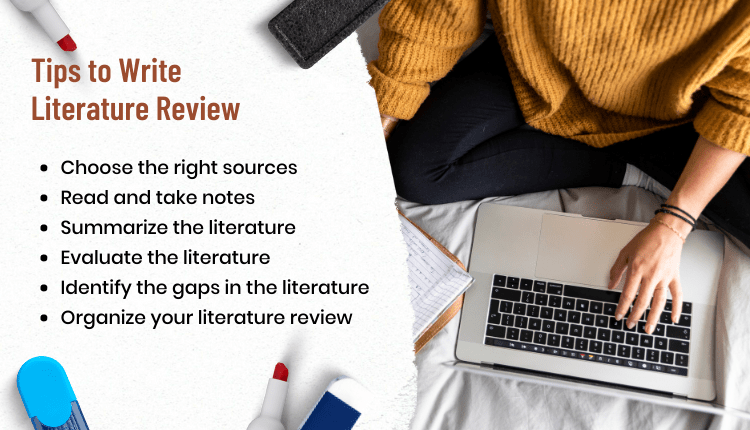
Here are some key steps to writing a literature review :
1. Choose the right sources
Start by identifying relevant sources for your literature review. This may include academic journals, books, conference proceedings, and theses. Make sure to choose only the most relevant and up-to-date sources.
2. Read and take notes
Once you’ve identified your sources, it’s time to read and take notes. Use a system to keep track of the information and be sure to note the author, date, and key findings of each source.
3. Summarize the literature
In your literature review, you should summarize the key findings of each source, highlighting their relevance to your research. You should also synthesize the information, looking for patterns, similarities, and differences among the sources.
4. Evaluate the literature
A strong literature review should not just summarize the sources, but also evaluate them. This means examining their strengths and weaknesses and assessing their relevance to your research question .
5. Identify gaps in the literature
As you evaluate the sources, look for gaps in the existing knowledge and areas where further research is needed. This will help you to identify the significance of your research and justify the need for your study.
6. Organize your literature review
Once you’ve completed your evaluation, you should organize your literature review clearly and logically. This could be chronologically, thematically, or based on methodology.
By choosing the right sources, reading and taking notes, summarizing and evaluating the literature, identifying gaps, and organizing your review, you will be able to provide a thorough and well-supported foundation for the rest of your essay.
3. Methodology
The methodology section of an academic essay is where you describe the methods you used to conduct your research. This section is an opportunity to explain the steps you took to answer your research question and to justify why you chose these methods. The methodology should be detailed, precise, and transparent so that others can understand and replicate your study if necessary.
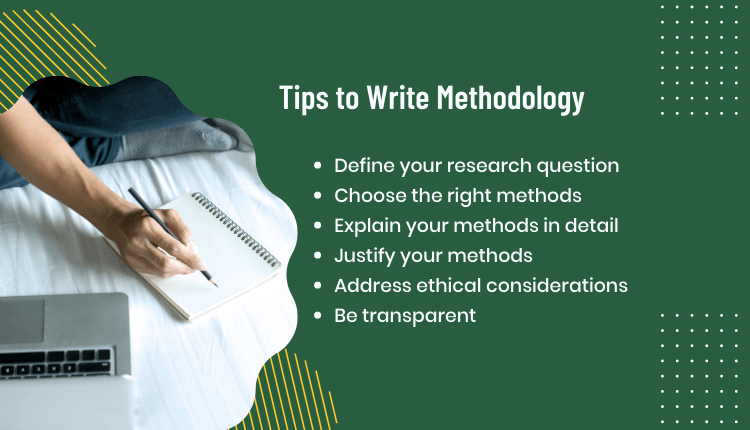
Here are some key steps to writing a strong methodology:
1. Define your research question
Before writing your methodology, you should have a clear understanding of your research question. This will guide the choice of methods you use and the information you collect.
2. Choose the right methods
The choice of methods should be guided by the research question. For example, if you’re conducting a survey, you would use a different method than if you were conducting a case study. Consider the strengths and limitations of each method, and choose the one that is best suited to your research question.
3. Explain your methods in detail
In your methodology, you should describe your methods in detail, so that others can understand how you conducted your research. This should include information on the sample size, how you collected the data, and any instruments or techniques you used.
4. Justify your methods
You should justify why you chose the methods you used and how they are appropriate for answering your research question. This might involve a discussion of the limitations of your methods and how they affect the results.
5. Address ethical considerations
If your research involved human subjects, you must address ethical considerations in your methodology. This might include information on informed consent, data confidentiality, and any potential risks to participants.
6. Be transparent
Your methodology should be transparent and honest so that others can understand and replicate your study if necessary. Be sure to report all of the methods you used, even if the results were not what you expected.
By defining your research question, choosing the right methods, explaining your methods in detail, justifying your methods, addressing ethical considerations, and being transparent, you will be able to provide a thorough and well-supported methodology for your essay.
The results section of an academic essay is where you present the findings of your research. This section should be clear, concise, and objective, and should present the data without any interpretation or discussion. The results should be organized logically and should include tables, figures, and other visual aids as necessary.

Here are some key steps to writing a strong results section:
1. Summarize the data
The first step in writing the results section is to summarize the data you collected. This might involve calculating means, standard deviations, and other descriptive statistics , depending on the type of data you collected.
2. Organize the results
This might involve presenting the results for each hypothesis, each research question, or each variable, depending on the nature of your study.
3. Use visual aids
Visual aids, such as tables and figures , can help to clarify and simplify the results. Make sure to label each visual aid clearly, and provide a caption that explains what the visual aid is showing.
4. Be objective
The results section should be objective, presenting the data without any interpretation or discussion. The interpretation of the results should be left to the discussion section.
5. Report results accurately
The results section should report the results accurately and precisely. This might involve rounding numbers to a specified number of decimal places, or using appropriate units of measurement.
In summary, by summarizing the data, organizing the results, using visual aids, being objective, and reporting the results accurately, you will be able to present your findings in a clear and compelling manner.
5. Discussion
The discussion section of an academic essay is where you interpret the results of your research and relate them to your research question and the broader literature. This section is an opportunity to conclude, make recommendations, and reflect on the strengths and limitations of your study. The discussion should be well-organized and should provide a clear and concise interpretation of the results.
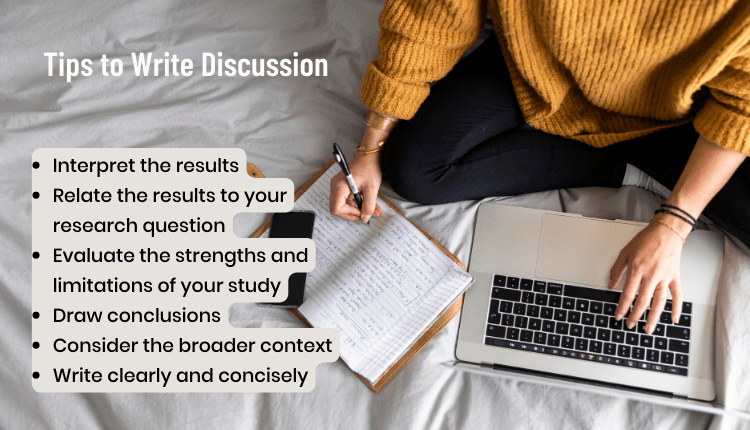
Here are some key steps to writing a strong discussion section:
1. Interpret the results
The first step in writing the discussion section is to interpret the results of your study. This might involve comparing your results to previous research, explaining any unexpected results, and drawing conclusions about the implications of your findings.
2. Relate the results to your research question
The discussion should relate the results of your study to your research question, demonstrating how the results answer the question and providing insights into the topic.
3. Evaluate the strengths and limitations of your study
The discussion should include an evaluation of the strengths and limitations of your study, addressing any limitations that might affect the validity of the results, and suggesting areas for future research.
4. Draw conclusions
The discussion should conclude the results of the study, make recommendations based on the findings, and discuss the implications for future research.
5. Consider the broader context
The discussion should consider the broader context of the research, relating the findings to the broader literature and making connections to other related fields.
6. Write clearly and concisely
The discussion should be well-written and easy to understand, using clear and concise language. Avoid using technical jargon, and make sure to define any terms that may be unfamiliar to your reader.
6. Conclusion
The conclusion of an academic essay is the final section in which you summarize the key points of your argument and provide closure to your reader. This section should be concise and to the point, reiterating the main points of your essay and providing a final perspective on your topic. The conclusion should also reflect on the implications of your research, considering the broader context of your study and its contributions to the field.

Here are some key steps to writing a strong conclusion:
1. Summarize the key points
The first step in writing the conclusion is to summarize the key points of your essay. This might involve restating your research question, summarizing your findings, and reiterating your arguments.
2. Reflect on the implications of your research
The conclusion should reflect on the implications of your research, considering the broader context of your study and its contributions to the field. This might involve discussing the potential applications of your findings, considering any ethical implications, or discussing future directions for research.
3. Provide closure
The conclusion should provide closure to your reader, bringing your argument to a logical end and tying up any loose ends. This might involve suggesting a conclusion based on your research, or providing a final perspective on your topic.
4. Avoid introducing new information
The conclusion should avoid introducing new information or arguments that were not discussed in the body of your essay. This might confuse your reader and undermine the coherence of your argument.
5. Write concisely
The conclusion should be concise, using clear and concise language to summarize the key points of your essay. Avoid using technical jargon, and make sure to write in a way that is easy for your reader to understand.
By summarizing the key points, reflecting on the implications of your research, providing closure, avoiding introducing new information, and writing concisely, you will be able to provide a compelling conclusion to your argument.
7. References
The references section of an academic essay is a crucial component that provides a list of the sources you used in your research and writing. The purpose of the references section is to give credit to the authors whose work you have used, to provide evidence for your arguments, and to support the validity of your research.
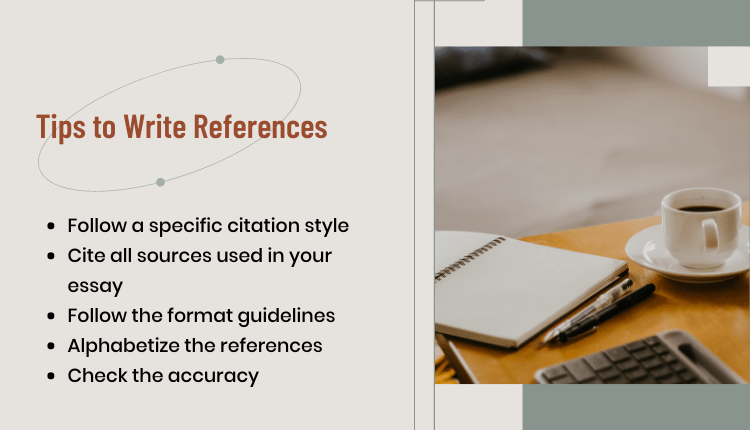
Here are some key steps to writing a strong references section:
1. Follow a specific citation style
The first step in writing the references section is to follow a specific citation style. There are several citation styles used in academic writing, including APA , MLA , and Chicago , and it is important to choose the one that is appropriate for your discipline and the type of essay you are writing.
2. Cite all sources used in your essay
The references section should include a citation for all sources that you used in your essay, including books, journal articles, websites, and other types of sources.
3. Follow the format guidelines
The references section should be formatted according to the specific citation style that you have chosen. This might involve including information such as the author’s name, the title of the source, the publication date, and the page numbers for any direct quotes or paraphrased material.
4. Alphabetize the references
The references section should be alphabetized according to the author’s last name, or the first word of the title for sources without authors.

5. Check for accuracy
Before submitting your essay, make sure to check the references section for accuracy, verifying that all of the information is correct and that all of the sources are cited properly.
By following a specific citation style, citing all sources used in your essay, following the format guidelines, alphabetizing the references, and checking for accuracy, you will be able to provide a comprehensive and well-documented references section for your essay.
8. Appendices
The appendices section of an academic essay is an optional component that provides additional information that supports the main argument or research findings. This section might include materials such as graphs, tables, maps, images, or other types of data or supplementary information.
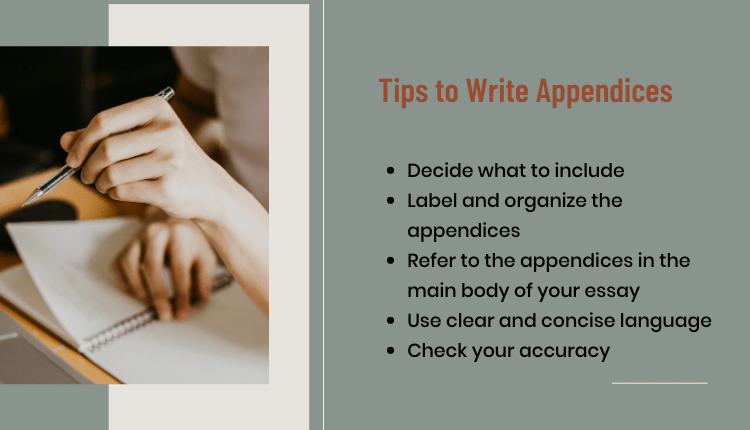
Here are some key steps to writing a strong appendices section:
1. Decide what to include
The first step in writing the appendices section is to decide what to include. This might involve evaluating the relevance of different types of information and determining which information is necessary to support your argument.
2. Label and organize the appendices
The appendices should be labeled and organized clearly and consistently, making it easy for the reader to understand the information being presented. This might involve including a title or description for each appendix, and numbering the appendices in a logical order.
3. Refer to the appendices in the main body of your essay
The appendices should be referred to in the main body of your essay, helping to connect the appendices to your argument. This might involve including a reference to the appendix in your text, or including a cross-reference to the appendix in your table of contents.
4. Use clear and concise language
The appendices should be written using clear and concise language, making it easy for the reader to understand the information being presented. Avoid using technical jargon, and make sure to write in a way that is accessible to your reader.
Before submitting your essay, make sure to check the appendices section for accuracy, verifying that all of the information is correct and that all of the tables, graphs, and other materials are properly labeled and organized.
By deciding what to include, labeling and organizing the appendices, referring to the appendices in the main body of your essay, using clear and concise language, and checking for accuracy, you will be able to provide a comprehensive and well-documented appendices section for your essay.
In Conclusion
Writing an academic essay is a complex and challenging task that requires careful planning, research, writing, and revision. From developing a strong thesis statement and researching the topic to writing the introduction, literature review, methodology, results, discussion, conclusion, and references, each step in the essay writing process requires attention to detail and a commitment to producing a high-quality essay.
By following the guidelines and tips outlined in this blog, you will be able to write a clear and well-structured essay that effectively communicates your argument, supports your claims with evidence, and meets the expectations of your reader.
In conclusion, writing an academic essay is a multi-step process that requires time, effort, and dedication. However, by breaking the process down into manageable steps, and by focusing on the key elements of writing an effective essay, you will be able to produce a high-quality essay that meets the expectations of your reader and contributes to your academic or professional success.
The best info ever thanks keep going like this 👌 🙌 👏 👍
It’s clearly and interesting work. I will use ir for My study and work i’m education un Patagonia, Argentina. Thanks Shrutika.
Rate this article Cancel Reply
Your email address will not be published.

Enago Academy's Most Popular Articles

- Reporting Research
Academic Essay Writing Made Simple: 4 types and tips
The pen is mightier than the sword, they say, and nowhere is this more evident…

- AI in Academia
- Trending Now
Simplifying the Literature Review Journey — A comparative analysis of 5 AI summarization tools
Imagine having to skim through and read mountains of research papers and books, only to…

Choosing the Right Analytical Approach: Thematic analysis vs. content analysis for data interpretation
In research, choosing the right approach to understand data is crucial for deriving meaningful insights.…

Comparing Cross Sectional and Longitudinal Studies: 5 steps for choosing the right approach
The process of choosing the right research design can put ourselves at the crossroads of…

- Career Corner
Unlocking the Power of Networking in Academic Conferences
Embarking on your first academic conference experience? Fear not, we got you covered! Academic conferences…
Choosing the Right Analytical Approach: Thematic analysis vs. content analysis for…
Comparing Cross Sectional and Longitudinal Studies: 5 steps for choosing the right…
Research Recommendations – Guiding policy-makers for evidence-based decision making

Sign-up to read more
Subscribe for free to get unrestricted access to all our resources on research writing and academic publishing including:
- 2000+ blog articles
- 50+ Webinars
- 10+ Expert podcasts
- 50+ Infographics
- 10+ Checklists
- Research Guides
We hate spam too. We promise to protect your privacy and never spam you.
- Academic Skills
- Reading, writing and referencing
Writing a great essay
This resource covers key considerations when writing an essay.
While reading a student’s essay, markers will ask themselves questions such as:
- Does this essay directly address the set task?
- Does it present a strong, supported position?
- Does it use relevant sources appropriately?
- Is the expression clear, and the style appropriate?
- Is the essay organised coherently? Is there a clear introduction, body and conclusion?
You can use these questions to reflect on your own writing. Here are six top tips to help you address these criteria.
1. Analyse the question
Student essays are responses to specific questions. As an essay must address the question directly, your first step should be to analyse the question. Make sure you know exactly what is being asked of you.
Generally, essay questions contain three component parts:
- Content terms: Key concepts that are specific to the task
- Limiting terms: The scope that the topic focuses on
- Directive terms: What you need to do in relation to the content, e.g. discuss, analyse, define, compare, evaluate.
Look at the following essay question:
Discuss the importance of light in Gothic architecture.
- Content terms: Gothic architecture
- Limiting terms: the importance of light. If you discussed some other feature of Gothic architecture, for example spires or arches, you would be deviating from what is required. This essay question is limited to a discussion of light. Likewise, it asks you to write about the importance of light – not, for example, to discuss how light enters Gothic churches.
- Directive term: discuss. This term asks you to take a broad approach to the variety of ways in which light may be important for Gothic architecture. You should introduce and consider different ideas and opinions that you have met in academic literature on this topic, citing them appropriately .
For a more complex question, you can highlight the key words and break it down into a series of sub-questions to make sure you answer all parts of the task. Consider the following question (from Arts):
To what extent can the American Revolution be understood as a revolution ‘from below’? Why did working people become involved and with what aims in mind?
The key words here are American Revolution and revolution ‘from below’. This is a view that you would need to respond to in this essay. This response must focus on the aims and motivations of working people in the revolution, as stated in the second question.
2. Define your argument
As you plan and prepare to write the essay, you must consider what your argument is going to be. This means taking an informed position or point of view on the topic presented in the question, then defining and presenting a specific argument.
Consider these two argument statements:
The architectural use of light in Gothic cathedrals physically embodied the significance of light in medieval theology.
In the Gothic cathedral of Cologne, light served to accentuate the authority and ritual centrality of the priest.
Statements like these define an essay’s argument. They give coherence by providing an overarching theme and position towards which the entire essay is directed.
3. Use evidence, reasoning and scholarship
To convince your audience of your argument, you must use evidence and reasoning, which involves referring to and evaluating relevant scholarship.
- Evidence provides concrete information to support your claim. It typically consists of specific examples, facts, quotations, statistics and illustrations.
- Reasoning connects the evidence to your argument. Rather than citing evidence like a shopping list, you need to evaluate the evidence and show how it supports your argument.
- Scholarship is used to show how your argument relates to what has been written on the topic (citing specific works). Scholarship can be used as part of your evidence and reasoning to support your argument.
4. Organise a coherent essay
An essay has three basic components - introduction, body and conclusion.
The purpose of an introduction is to introduce your essay. It typically presents information in the following order:
- A general statement about the topic that provides context for your argument
- A thesis statement showing your argument. You can use explicit lead-ins, such as ‘This essay argues that...’
- A ‘road map’ of the essay, telling the reader how it is going to present and develop your argument.
Example introduction
"To what extent can the American Revolution be understood as a revolution ‘from below’? Why did working people become involved and with what aims in mind?"
Introduction*
Historians generally concentrate on the twenty-year period between 1763 and 1783 as the period which constitutes the American Revolution [This sentence sets the general context of the period] . However, when considering the involvement of working people, or people from below, in the revolution it is important to make a distinction between the pre-revolutionary period 1763-1774 and the revolutionary period 1774-1788, marked by the establishment of the continental Congress(1) [This sentence defines the key term from below and gives more context to the argument that follows] . This paper will argue that the nature and aims of the actions of working people are difficult to assess as it changed according to each phase [This is the thesis statement] . The pre-revolutionary period was characterised by opposition to Britain’s authority. During this period the aims and actions of the working people were more conservative as they responded to grievances related to taxes and scarce land, issues which directly affected them. However, examination of activities such as the organisation of crowd action and town meetings, pamphlet writing, formal communications to Britain of American grievances and physical action in the streets, demonstrates that their aims and actions became more revolutionary after 1775 [These sentences give the ‘road map’ or overview of the content of the essay] .
The body of the essay develops and elaborates your argument. It does this by presenting a reasoned case supported by evidence from relevant scholarship. Its shape corresponds to the overview that you provided in your introduction.
The body of your essay should be written in paragraphs. Each body paragraph should develop one main idea that supports your argument. To learn how to structure a paragraph, look at the page developing clarity and focus in academic writing .
Your conclusion should not offer any new material. Your evidence and argumentation should have been made clear to the reader in the body of the essay.
Use the conclusion to briefly restate the main argumentative position and provide a short summary of the themes discussed. In addition, also consider telling your reader:
- What the significance of your findings, or the implications of your conclusion, might be
- Whether there are other factors which need to be looked at, but which were outside the scope of the essay
- How your topic links to the wider context (‘bigger picture’) in your discipline.
Do not simply repeat yourself in this section. A conclusion which merely summarises is repetitive and reduces the impact of your paper.
Example conclusion
Conclusion*.
Although, to a large extent, the working class were mainly those in the forefront of crowd action and they also led the revolts against wealthy plantation farmers, the American Revolution was not a class struggle [This is a statement of the concluding position of the essay]. Working people participated because the issues directly affected them – the threat posed by powerful landowners and the tyranny Britain represented. Whereas the aims and actions of the working classes were more concerned with resistance to British rule during the pre-revolutionary period, they became more revolutionary in nature after 1775 when the tension with Britain escalated [These sentences restate the key argument]. With this shift, a change in ideas occurred. In terms of considering the Revolution as a whole range of activities such as organising riots, communicating to Britain, attendance at town hall meetings and pamphlet writing, a difficulty emerges in that all classes were involved. Therefore, it is impossible to assess the extent to which a single group such as working people contributed to the American Revolution [These sentences give final thoughts on the topic].
5. Write clearly
An essay that makes good, evidence-supported points will only receive a high grade if it is written clearly. Clarity is produced through careful revision and editing, which can turn a good essay into an excellent one.
When you edit your essay, try to view it with fresh eyes – almost as if someone else had written it.
Ask yourself the following questions:
Overall structure
- Have you clearly stated your argument in your introduction?
- Does the actual structure correspond to the ‘road map’ set out in your introduction?
- Have you clearly indicated how your main points support your argument?
- Have you clearly signposted the transitions between each of your main points for your reader?
- Does each paragraph introduce one main idea?
- Does every sentence in the paragraph support that main idea?
- Does each paragraph display relevant evidence and reasoning?
- Does each paragraph logically follow on from the one before it?
- Is each sentence grammatically complete?
- Is the spelling correct?
- Is the link between sentences clear to your readers?
- Have you avoided redundancy and repetition?
See more about editing on our editing your writing page.
6. Cite sources and evidence
Finally, check your citations to make sure that they are accurate and complete. Some faculties require you to use a specific citation style (e.g. APA) while others may allow you to choose a preferred one. Whatever style you use, you must follow its guidelines correctly and consistently. You can use Recite, the University of Melbourne style guide, to check your citations.
Further resources
- Germov, J. (2011). Get great marks for your essays, reports and presentations (3rd ed.). NSW: Allen and Unwin.
- Using English for Academic Purposes: A guide for students in Higher Education [online]. Retrieved January 2020 from http://www.uefap.com
- Williams, J.M. & Colomb, G. G. (2010) Style: Lessons in clarity and grace. 10th ed. New York: Longman.
* Example introduction and conclusion adapted from a student paper.
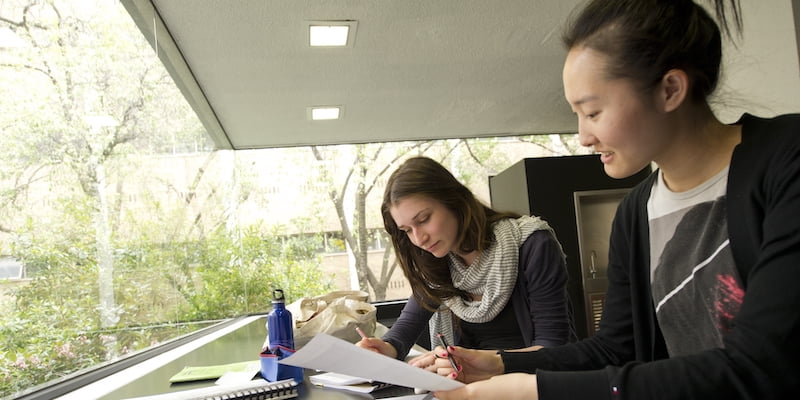
Looking for one-on-one advice?
Get tailored advice from an Academic Skills Adviser by booking an Individual appointment, or get quick feedback from one of our Academic Writing Mentors via email through our Writing advice service.
Go to Student appointments
Purdue Online Writing Lab Purdue OWL® College of Liberal Arts
Academic Writing

Welcome to the Purdue OWL
This page is brought to you by the OWL at Purdue University. When printing this page, you must include the entire legal notice.
Copyright ©1995-2018 by The Writing Lab & The OWL at Purdue and Purdue University. All rights reserved. This material may not be published, reproduced, broadcast, rewritten, or redistributed without permission. Use of this site constitutes acceptance of our terms and conditions of fair use.
In this section
Subsections.
Tips for Reading an Assignment Prompt
Asking analytical questions, introductions, what do introductions across the disciplines have in common, anatomy of a body paragraph, transitions, tips for organizing your essay, counterargument, conclusions.

Basic Rules for Academic Writing
Table of Contents
What is the Purpose of Academic Writing?
Although it goes without saying, when writing at a college or university level, students are expected to write in an academic style and this is expected in nearly all forms of assignments including, but not limited to:
- research papers
- presentations
- term papers
- thesis/dissertations
- and other written pieces
Although these may go by different names, the goal of these assignments remains the same – to test your knowledge in the subject area through a written task .
This makes academic writing arguably the most important skill for effective academic communication, (although it may seem like specifically designed instruments of torture to grad students).
The truth is academic papers are not actually meant to be excruciatingly painful and put off until the end. Instead, if you approach the paper early on, and think of it as an opportunity to explore various topics of interest within your field of study, you can avoid the last-minute rush, and even turn-in a decent paper. But there are some basic rules you must follow when writing your academic paper.
Academic papers must be written in a particular style, catered towards academic audiences such as scholars within the same discipline (who are most often your tutors and instructors). When starting on a written assignment, think about your readers – what do they expect from you? The simple answer: they want you to convey your findings and arguments in a scientific and professional manner.
Read below for a snapshot of the dos and don’ts in academic writing or scroll further down for a detailed guide on the rules for academic writing.
What are the Basics of Academic Writing?
Here are some basic rules to follow to ensure the content of your paper meets the academic writing style required by most universities.
1. Use Formal Language
X Don’t use informal language X Don’t use first person narrative ✓ Use technical terms within your field ✓ Use transition words and punctuations to connect complex sentences
2. Maintain Structured Writing
✓ Include separate introduction and conclusion ✓ State clear aims at the beginning ✓ Use headings and sub-headings to section your paper ✓ Create flow between your paragraphs (for easy readability, write them in a sequence) X Don’t discuss unrelated points in the same paragraph X Don’t introduce new points in conclusions
3. Remain Objective
X Avoid biased writing (i.e. use neutral tone without favoring any one angle) ✓ Discuss all sides of the argument (i.e. multiple perspectives) to draw your stance from it ✓ Evaluate the credibility of your sources for major arguments ✓ List out the limitations of your work
4. Conduct Evidence-based Research
✓ Read current, relevant, and high-quality journal articles within your study subject ✓ Provide scholarly evidence from credible sources to support your points X Don’t simply re-state the findings of others; instead inform how it agrees/ disagrees with your findings ✓ Derive your original idea from the analysis of all your arguments
Detailed Guide on the Basic Rules of Academic Writing
1. formal language.
In academic papers, avoid the use of informal language at all costs! This means, stay away from:
- slang words (such as “low-key” and “lit”)
- first person pronouns (such as “I” and “we”)
- contractions (such as “can’t” and “don’t”)
- adverbs of frequency (such as “always” and “never”)
- dramatic superlatives (such as “very” and “extremely”)
For example, instead of concluding “the results of the study are very confusing”, you can state “the results are inconclusive” to sound more balanced and sophisticated. That’s not it, there’s a whole list of taboo words that must never make its way into any academic paper, which you can read about further to make you avoid them, if possible.
However, do note that the use of first person may be acceptable, or even recommended, in reflection assignments , where the student is expected to reflect on their personal learning experience.
For example, when reflecting on the process undertaken during a research paper, you could state “I improved my time management skills through this research as I learned to break down bigger tasks into a series of smaller steps”. Unless recounting of your personal growth journey is a specific assignment requirement, for the most part, stick to a third person narrative in your paper! (here’s a detailed guide on how to write a reflection paper).
Plus, in terms of vocabulary, the use of appropriate technical terms relevant to your field of study will give readers the impression that you are knowledgeable and proficient in this subject . Show off to your readers that you are a pro at this. But of course, you also need to define such technical terms wherever necessary, in order to offer further insight to your readers. For example:
- if you are writing about water pollution, use scientific words like “bioaccumulation” and “biomagnification”
- if you are focusing on mergers and acquisitions, use industry-specific terms like “due diligence” and “hostile takeovers”
- if you are discussing “Super Bowl”, talk about “blitz” and “clothesline”
You should also break-up and connect long sentences with punctuations like semi-colon (;) and transition words like “however”, “nevertheless”, “although”, “moreover”, “furthermore”, etc. This can help readers understand the link between your points, while you simplify it for them. Thus, academic writing can be more complex than general writing, involving the use of complex sentences and technical jargon; for example, note how the sentences within this paragraph are broken down and linked using semi-colons and transition conjunctions, and how we drew the paragraph’s conclusion from it.
2. Structured Writing
Academic writing is structured as it most often requires you to begin with an introduction stating the aims of the written piece, and end with a conclusion summarizing the key findings and implications. We have a dedicated guide focused on the basics of writing assignment structure which you can take a look at if you want to know all the relevant headings and subheadings that go into them, and what to write under each.
Examiners (who are your target readers, if you are a student) always look for your aims or topic sentence in the initial section, so that they know you are aware of the purpose of the assignment and what you hope to achieve. That’s why you need to spell out your aims clearly in your opening paragraphs to score that extra cookie point.
You also need to go one step further and section your paper using clear headings and subheadings within the body paragraphs, unless it is an essay or otherwise stated.Note: essays do not generally require sub-headings, but as with other academic papers, each paragraph must present a single theme or idea. That is, similar points should be clubbed together within the paragraph , supported by relevant evidences and examples, critical arguments, and key takeaways.
Also, try to be a good narrator – tell your story in a logical order! That means the paragraphs must flow one after the other in a sequence , without being abrupt, redundant or repetitive. This will ensure your readers are able to follow your trail of arguments and engage with your content, ultimately leading to the impression that your writing is structured and cohesive. A great way to logically structure your paper is to make an outline of topics to cover as your first step, by paying attention to your assignment brief or assignment requirements and drawing on the assignment rubric or marketing criteria.
(Click here to know how to structure your paper based on the marking criteria/ assignment rubric and what headings/ sub-headings to choose).
3. Objectivity
There are always two sides to a story; but, as an academic writer and researcher, you need to remain impersonal, unbiased and search for the truth that lies somewhere in the middle-ground. That means, put aside your feelings, distance yourself from both sides, and write your paper as a third-party and neutral judge. Better yet, be an emotionless bot when it comes to representing facts, analyzing information and drawing interpretations.
But remember, your assignment is not just about stating the facts or listing out information taken from elsewhere. Although you will draw from the work of other scholars, you must also evaluate that information in your paper and correlate it with other similar studies, which may agree or disagree with your stance (see example below). By doing so, you would be showing objectively – that there are multiple perspectives and different sides to the argument, leading up to what you gather from all this by stating your clear point of view . Thus, you will be putting across your original idea in an objective and critical manner, as it is backed by evidence and balanced argument, rather than playing favoritism.
However, being completely objective in your paper is highly unlikely, as we have a subconscious tendency to subjectively select the text and sources which seem more suitable for our line of thinking. This introduces a certain level of research bias since your sources are not randomly chosen. But that’s okay, because you’re going to acknowledge this research flaw in your paper – let your reader know the limitations of your work . By being critical of your own research process in this manner, you can be sure that the examiner will notice your efforts to remain objective and will definitely grade you higher for it, as it sets your paper apart from others.
Although being objective is a general rule in academic writing, there are some exceptions where subjectivity is sought. For example, ethnographic and social researches draw on the personal interpretations of the author who observes a social phenomenon by living in or close to the studied society. In such a scenario, qualitative descriptive writing is adopted as the author seeks to describe the phenomenon and its impact on the society from a subjective/ personal point of view. Unless you are undertaking such a research, try to remain largely objective in your arguments to sound more systematic.
4. Evidence-Based Research
The use of reliable evidence to support your arguments will be the biggest point-scoring tactic you can master. In fact, this will be the main criteria to pass your assignment, because your course almost always requires you to read journal articles published in your subject area . That’s why tutors often tell you Wikipedia is not a reliable source. (But how can you still use Wikipedia for your research, without actually putting it in your paper? We’ve made a dedicated guide for using Wikipedia for academic research (because let’s be honest – Wikipedia gives you tons of useful information).
In reality, you are expected to support the arguments in your paper by drawing from existing studies , statistics, market reports, news articles and other scholarly literature , by citing these sources as evidences (see the example below). Such a specific requirement to cite and reference academic sources for your arguments differentiates academic writing from other forms of writing.
When we talk about these sources as evidences, always remember to choose a variety of high-quality and current papers (published within 5 years) to support your own ideas. How many references should you use in your academic paper?
You may be wondering how many references you should have in an essay – we recommend integrating 6-8 references for every 1000 words in your paper , unless the number of references are explicitly requested in your assignment task. We cover this in more detail in this guide on how many references you should have in an essay .
Concluding remarks about referencing
A common mistake that most students make while integrating references is simply re-stating what the authors have published in their paper. To actually use them as supporting evidence, you need question the credibility, reliability and generalizability of their findings , by either critiquing the author’s research methods and techniques or by comparing or contrasting them with similar studies examining the same topic.
This tells the reader that you have not only read these papers, but you are also synthesizing and correlating information from different sources and analyzing them in order to draw your own original idea . Although this can be overwhelming for a novice academic writer, it is actually not that tricky to accomplish . For a more detailed understanding of this, you can read our post on some referencing guidelines to help you write a better paper.
We cover this issue and various other common mistakes in referencing in our separate guide. So be sure to check that out as well for a more comprehensive understanding about referencing as it is worth reiterating that this is the core aspect that differentiates academic writing from other forms of written content.
Leave a Comment Cancel reply
Save my name, email, and website in this browser for the next time I comment.
Privacy Overview
11 Rules for Essay Paragraph Structure (with Examples)

Chris Drew (PhD)
Dr. Chris Drew is the founder of the Helpful Professor. He holds a PhD in education and has published over 20 articles in scholarly journals. He is the former editor of the Journal of Learning Development in Higher Education. [Image Descriptor: Photo of Chris]
Learn about our Editorial Process
How do you structure a paragraph in an essay?
If you’re like the majority of my students, you might be getting your basic essay paragraph structure wrong and getting lower grades than you could!
In this article, I outline the 11 key steps to writing a perfect paragraph. But, this isn’t your normal ‘how to write an essay’ article. Rather, I’ll try to give you some insight into exactly what teachers look out for when they’re grading essays and figuring out what grade to give them.
You can navigate each issue below, or scroll down to read them all:
1. Paragraphs must be at least four sentences long 2. But, at most seven sentences long 3. Your paragraph must be Left-Aligned 4. You need a topic sentence 5 . Next, you need an explanation sentence 6. You need to include an example 7. You need to include citations 8. All paragraphs need to be relevant to the marking criteria 9. Only include one key idea per paragraph 10. Keep sentences short 11. Keep quotes short
Paragraph structure is one of the most important elements of getting essay writing right .
As I cover in my Ultimate Guide to Writing an Essay Plan , paragraphs are the heart and soul of your essay.
However, I find most of my students have either:
- forgotten how to write paragraphs properly,
- gotten lazy, or
- never learned it in the first place!
Paragraphs in essay writing are different from paragraphs in other written genres .
In fact, the paragraphs that you are reading now would not help your grades in an essay.
That’s because I’m writing in journalistic style, where paragraph conventions are vastly different.
For those of you coming from journalism or creative writing, you might find you need to re-learn paragraph writing if you want to write well-structured essay paragraphs to get top grades.
Below are eleven reasons your paragraphs are losing marks, and what to do about it!

Essay Paragraph Structure Rules
1. your paragraphs must be at least 4 sentences long.
In journalism and blog writing, a one-sentence paragraph is great. It’s short, to-the-point, and helps guide your reader. For essay paragraph structure, one-sentence paragraphs suck.
A one-sentence essay paragraph sends an instant signal to your teacher that you don’t have much to say on an issue.
A short paragraph signifies that you know something – but not much about it. A one-sentence paragraph lacks detail, depth and insight.
Many students come to me and ask, “what does ‘add depth’ mean?” It’s one of the most common pieces of feedback you’ll see written on the margins of your essay.
Personally, I think ‘add depth’ is bad feedback because it’s a short and vague comment. But, here’s what it means: You’ve not explained your point enough!
If you’re writing one-, two- or three-sentence essay paragraphs, you’re costing yourself marks.
Always aim for at least four sentences per paragraph in your essays.
This doesn’t mean that you should add ‘fluff’ or ‘padding’ sentences.
Make sure you don’t:
a) repeat what you said in different words, or b) write something just because you need another sentence in there.
But, you need to do some research and find something insightful to add to that two-sentence paragraph if you want to ace your essay.
Check out Points 5 and 6 for some advice on what to add to that short paragraph to add ‘depth’ to your paragraph and start moving to the top of the class.
- How to Make an Essay Longer
- How to Make an Essay Shorter
2. Your Paragraphs must not be more than 7 Sentences Long
Okay, so I just told you to aim for at least four sentences per paragraph. So, what’s the longest your paragraph should be?
Seven sentences. That’s a maximum.
So, here’s the rule:
Between four and seven sentences is the sweet spot that you need to aim for in every single paragraph.
Here’s why your paragraphs shouldn’t be longer than seven sentences:
1. It shows you can organize your thoughts. You need to show your teacher that you’ve broken up your key ideas into manageable segments of text (see point 10)
2. It makes your work easier to read. You need your writing to be easily readable to make it easy for your teacher to give you good grades. Make your essay easy to read and you’ll get higher marks every time.
One of the most important ways you can make your work easier to read is by writing paragraphs that are less than six sentences long.
3. It prevents teacher frustration. Teachers are just like you. When they see a big block of text their eyes glaze over. They get frustrated, lost, their mind wanders … and you lose marks.
To prevent teacher frustration, you need to ensure there’s plenty of white space in your essay. It’s about showing them that the piece is clearly structured into one key idea per ‘chunk’ of text.
Often, you might find that your writing contains tautologies and other turns of phrase that can be shortened for clarity.
3. Your Paragraph must be Left-Aligned
Turn off ‘Justified’ text and: Never. Turn. It. On. Again.
Justified text is where the words are stretched out to make the paragraph look like a square. It turns the writing into a block. Don’t do it. You will lose marks, I promise you! Win the psychological game with your teacher: left-align your text.
A good essay paragraph is never ‘justified’.
I’m going to repeat this, because it’s important: to prevent your essay from looking like a big block of muddy, hard-to-read text align your text to the left margin only.
You want white space on your page – and lots of it. White space helps your reader scan through your work. It also prevents it from looking like big blocks of text.
You want your reader reading vertically as much as possible: scanning, browsing, and quickly looking through for evidence you’ve engaged with the big ideas.
The justified text doesn’t help you do that. Justified text makes your writing look like a big, lumpy block of text that your reader doesn’t want to read.
What’s wrong with Center-Aligned Text?
While I’m at it, never, ever, center-align your text either. Center-aligned text is impossible to skim-read. Your teacher wants to be able to quickly scan down the left margin to get the headline information in your paragraph.
Not many people center-align text, but it’s worth repeating: never, ever center-align your essays.

Don’t annoy your reader. Left align your text.
4. Your paragraphs must have a Topic Sentence
The first sentence of an essay paragraph is called the topic sentence. This is one of the most important sentences in the correct essay paragraph structure style.
The topic sentence should convey exactly what key idea you’re going to cover in your paragraph.
Too often, students don’t let their reader know what the key idea of the paragraph is until several sentences in.
You must show what the paragraph is about in the first sentence.
You never, ever want to keep your reader in suspense. Essays are not like creative writing. Tell them straight away what the paragraph is about. In fact, if you can, do it in the first half of the first sentence .
I’ll remind you again: make it easy to grade your work. Your teacher is reading through your work trying to determine what grade to give you. They’re probably going to mark 20 assignments in one sitting. They have no interest in storytelling or creativity. They just want to know how much you know! State what the paragraph is about immediately and move on.
Suggested: Best Words to Start a Paragraph
Ideal Essay Paragraph Structure Example: Writing a Topic Sentence If your paragraph is about how climate change is endangering polar bears, say it immediately : “Climate change is endangering polar bears.” should be your first sentence in your paragraph. Take a look at first sentence of each of the four paragraphs above this one. You can see from the first sentence of each paragraph that the paragraphs discuss:
When editing your work, read each paragraph and try to distil what the one key idea is in your paragraph. Ensure that this key idea is mentioned in the first sentence .
(Note: if there’s more than one key idea in the paragraph, you may have a problem. See Point 9 below .)
The topic sentence is the most important sentence for getting your essay paragraph structure right. So, get your topic sentences right and you’re on the right track to a good essay paragraph.
5. You need an Explanation Sentence
All topic sentences need a follow-up explanation. The very first point on this page was that too often students write paragraphs that are too short. To add what is called ‘depth’ to a paragraph, you can come up with two types of follow-up sentences: explanations and examples.
Let’s take explanation sentences first.
Explanation sentences give additional detail. They often provide one of the following services:
Let’s go back to our example of a paragraph on Climate change endangering polar bears. If your topic sentence is “Climate change is endangering polar bears.”, then your follow-up explanation sentence is likely to explain how, why, where, or when. You could say:
Ideal Essay Paragraph Structure Example: Writing Explanation Sentences 1. How: “The warming atmosphere is melting the polar ice caps.” 2. Why: “The polar bears’ habitats are shrinking every single year.” 3. Where: “This is happening in the Antarctic ice caps near Greenland.” 4. When: “Scientists first noticed the ice caps were shrinking in 1978.”
You don’t have to provide all four of these options each time.
But, if you’re struggling to think of what to add to your paragraph to add depth, consider one of these four options for a good quality explanation sentence.
>>>RELATED ARTICLE: SHOULD YOU USE RHETORICAL QUESTIONS IN ESSAYS ?
6. Your need to Include an Example
Examples matter! They add detail. They also help to show that you genuinely understand the issue. They show that you don’t just understand a concept in the abstract; you also understand how things work in real life.
Example sentences have the added benefit of personalising an issue. For example, after saying “Polar bears’ habitats are shrinking”, you could note specific habitats, facts and figures, or even a specific story about a bear who was impacted.
Ideal Essay Paragraph Structure Example: Writing an ‘Example’ Sentence “For example, 770,000 square miles of Arctic Sea Ice has melted in the past four decades, leading Polar Bear populations to dwindle ( National Geographic, 2018 )
In fact, one of the most effective politicians of our times – Barrack Obama – was an expert at this technique. He would often provide examples of people who got sick because they didn’t have healthcare to sell Obamacare.
What effect did this have? It showed the real-world impact of his ideas. It humanised him, and got him elected president – twice!
Be like Obama. Provide examples. Often.
7. All Paragraphs need Citations
Provide a reference to an academic source in every single body paragraph in the essay. The only two paragraphs where you don’t need a reference is the introduction and conclusion .
Let me repeat: Paragraphs need at least one reference to a quality scholarly source .
Let me go even further:
Students who get the best marks provide two references to two different academic sources in every paragraph.
Two references in a paragraph show you’ve read widely, cross-checked your sources, and given the paragraph real thought.
It’s really important that these references link to academic sources, not random websites, blogs or YouTube videos. Check out our Seven Best types of Sources to Cite in Essays post to get advice on what sources to cite. Number 6 w ill surprise you!
Ideal Essay Paragraph Structure Example: In-Text Referencing in Paragraphs Usually, in-text referencing takes the format: (Author, YEAR), but check your school’s referencing formatting requirements carefully. The ‘Author’ section is the author’s last name only. Not their initials. Not their first name. Just their last name . My name is Chris Drew. First name Chris, last name Drew. If you were going to reference an academic article I wrote in 2019, you would reference it like this: (Drew, 2019).
Where do you place those two references?
Place the first reference at the end of the first half of the paragraph. Place the second reference at the end of the second half of the paragraph.
This spreads the references out and makes it look like all the points throughout the paragraph are backed up by your sources. The goal is to make it look like you’ve reference regularly when your teacher scans through your work.
Remember, teachers can look out for signposts that indicate you’ve followed academic conventions and mentioned the right key ideas.
Spreading your referencing through the paragraph helps to make it look like you’ve followed the academic convention of referencing sources regularly.
Here are some examples of how to reference twice in a paragraph:
- If your paragraph was six sentences long, you would place your first reference at the end of the third sentence and your second reference at the end of the sixth sentence.
- If your paragraph was five sentences long, I would recommend placing one at the end of the second sentence and one at the end of the fifth sentence.
You’ve just read one of the key secrets to winning top marks.
8. Every Paragraph must be relevant to the Marking Criteria
Every paragraph must win you marks. When you’re editing your work, check through the piece to see if every paragraph is relevant to the marking criteria.
For the British: In the British university system (I’m including Australia and New Zealand here – I’ve taught at universities in all three countries), you’ll usually have a ‘marking criteria’. It’s usually a list of between two and six key learning outcomes your teacher needs to use to come up with your score. Sometimes it’s called a:
- Marking criteria
- Marking rubric
- (Key) learning outcome
- Indicative content
Check your assignment guidance to see if this is present. If so, use this list of learning outcomes to guide what you write. If your paragraphs are irrelevant to these key points, delete the paragraph .
Paragraphs that don’t link to the marking criteria are pointless. They won’t win you marks.
For the Americans: If you don’t have a marking criteria / rubric / outcomes list, you’ll need to stick closely to the essay question or topic. This goes out to those of you in the North American system. North America (including USA and Canada here) is often less structured and the professor might just give you a topic to base your essay on.
If all you’ve got is the essay question / topic, go through each paragraph and make sure each paragraph is relevant to the topic.
For example, if your essay question / topic is on “The Effects of Climate Change on Polar Bears”,
- Don’t talk about anything that doesn’t have some connection to climate change and polar bears;
- Don’t talk about the environmental impact of oil spills in the Gulf of Carpentaria;
- Don’t talk about black bear habitats in British Columbia.
- Do talk about the effects of climate change on polar bears (and relevant related topics) in every single paragraph .
You may think ‘stay relevant’ is obvious advice, but at least 20% of all essays I mark go off on tangents and waste words.
Stay on topic in Every. Single. Paragraph. If you want to learn more about how to stay on topic, check out our essay planning guide .
9. Only have one Key Idea per Paragraph
One key idea for each paragraph. One key idea for each paragraph. One key idea for each paragraph.
Don’t forget!
Too often, a student starts a paragraph talking about one thing and ends it talking about something totally different. Don’t be that student.
To ensure you’re focussing on one key idea in your paragraph, make sure you know what that key idea is. It should be mentioned in your topic sentence (see Point 3 ). Every other sentence in the paragraph adds depth to that one key idea.
If you’ve got sentences in your paragraph that are not relevant to the key idea in the paragraph, they don’t fit. They belong in another paragraph.
Go through all your paragraphs when editing your work and check to see if you’ve veered away from your paragraph’s key idea. If so, you might have two or even three key ideas in the one paragraph.
You’re going to have to get those additional key ideas, rip them out, and give them paragraphs of their own.
If you have more than one key idea in a paragraph you will lose marks. I promise you that.
The paragraphs will be too hard to read, your reader will get bogged down reading rather than scanning, and you’ll have lost grades.
10. Keep Sentences Short
If a sentence is too long it gets confusing. When the sentence is confusing, your reader will stop reading your work. They will stop reading the paragraph and move to the next one. They’ll have given up on your paragraph.
Short, snappy sentences are best.
Shorter sentences are easier to read and they make more sense. Too often, students think they have to use big, long, academic words to get the best marks. Wrong. Aim for clarity in every sentence in the paragraph. Your teacher will thank you for it.
The students who get the best marks write clear, short sentences.
When editing your draft, go through your essay and see if you can shorten your longest five sentences.
(To learn more about how to write the best quality sentences, see our page on Seven ways to Write Amazing Sentences .)
11. Keep Quotes Short
Eighty percent of university teachers hate quotes. That’s not an official figure. It’s my guestimate based on my many interactions in faculty lounges. Twenty percent don’t mind them, but chances are your teacher is one of the eight out of ten who hate quotes.
Teachers tend to be turned off by quotes because it makes it look like you don’t know how to say something on your own words.
Now that I’ve warned you, here’s how to use quotes properly:
Ideal Essay Paragraph Structure Example: How To Use Quotes in University-Level Essay Paragraphs 1. Your quote should be less than one sentence long. 2. Your quote should be less than one sentence long. 3. You should never start a sentence with a quote. 4. You should never end a paragraph with a quote. 5 . You should never use more than five quotes per essay. 6. Your quote should never be longer than one line in a paragraph.
The minute your teacher sees that your quote takes up a large chunk of your paragraph, you’ll have lost marks.
Your teacher will circle the quote, write a snarky comment in the margin, and not even bother to give you points for the key idea in the paragraph.
Avoid quotes, but if you really want to use them, follow those five rules above.
I’ve also provided additional pages outlining Seven tips on how to use Quotes if you want to delve deeper into how, when and where to use quotes in essays. Be warned: quoting in essays is harder than you thought.

Follow the advice above and you’ll be well on your way to getting top marks at university.
Writing essay paragraphs that are well structured takes time and practice. Don’t be too hard on yourself and keep on trying!
Below is a summary of our 11 key mistakes for structuring essay paragraphs and tips on how to avoid them.
I’ve also provided an easy-to-share infographic below that you can share on your favorite social networking site. Please share it if this article has helped you out!
11 Biggest Essay Paragraph Structure Mistakes you’re probably Making
1. Your paragraphs are too short 2. Your paragraphs are too long 3. Your paragraph alignment is ‘Justified’ 4. Your paragraphs are missing a topic sentence 5 . Your paragraphs are missing an explanation sentence 6. Your paragraphs are missing an example 7. Your paragraphs are missing references 8. Your paragraphs are not relevant to the marking criteria 9. You’re trying to fit too many ideas into the one paragraph 10. Your sentences are too long 11. Your quotes are too long

- Chris Drew (PhD) https://helpfulprofessor.com/author/chris-drew-phd-2/ 10 Reasons you’re Perpetually Single
- Chris Drew (PhD) https://helpfulprofessor.com/author/chris-drew-phd-2/ 20 Montessori Toddler Bedrooms (Design Inspiration)
- Chris Drew (PhD) https://helpfulprofessor.com/author/chris-drew-phd-2/ 21 Montessori Homeschool Setups
- Chris Drew (PhD) https://helpfulprofessor.com/author/chris-drew-phd-2/ 101 Hidden Talents Examples
4 thoughts on “11 Rules for Essay Paragraph Structure (with Examples)”
Hello there. I noticed that throughout this article on Essay Writing, you keep on saying that the teacher won’t have time to go through the entire essay. Don’t you think this is a bit discouraging that with all the hard work and time put into your writing, to know that the teacher will not read through the entire paper?

Hi Clarence,
Thanks so much for your comment! I love to hear from readers on their thoughts.
Yes, I agree that it’s incredibly disheartening.
But, I also think students would appreciate hearing the truth.
Behind closed doors many / most university teachers are very open about the fact they ‘only have time to skim-read papers’. They regularly bring this up during heated faculty meetings about contract negotiations! I.e. in one university I worked at, we were allocated 45 minutes per 10,000 words – that’s just over 4 minutes per 1,000 word essay, and that’d include writing the feedback, too!
If students know the truth, they can better write their essays in a way that will get across the key points even from a ‘skim-read’.
I hope to write candidly on this website – i.e. some of this info will never be written on university blogs because universities want to hide these unfortunate truths from students.
Thanks so much for stopping by!
Regards, Chris
This is wonderful and helpful, all I say is thank you very much. Because I learned a lot from this site, own by chris thank you Sir.
Thank you. This helped a lot.
Leave a Comment Cancel Reply
Your email address will not be published. Required fields are marked *

13 Rules for Writing Good Essays
To write a good essay, you have to make your message clear..
Posted March 7, 2018 | Reviewed by Jessica Schrader
To write a good university essay you have to make your message clear. This means organizing your key points, supporting them with a series of evidence-based arguments, and wrapping it all up at the end so the reader knows what they've learned. To do this well, you need to take the reader's perspective. If you can see what might trip them up as they read your work, then you can avoid pitfalls that will confuse or bore them. Here are some tips to help you avoid the easy pitfalls. Once understood, these rules can be broken. But if you're unclear on how to approach your writing, these tips can help.
1. Your opening paragraph should clearly describe what you are going to discuss in the essay. These three things are vital: What’s the thesis (or problem), why is it important, and how are you going to address it? If you have each of those items in your opening paragraph your reader will know what they are reading, why they are reading it, and what they can expect to get out of it.
2. Organize the essay so that it covers a set list of subtopics that each support your main thesis. If it's a long essay, you should break it up into sections with headings that focus on specific subtopics. Introduce these topics in the opening paragraph of the essay (see 1 above). Overall, you want to organize information so it is easy to understand and remember.
3. Start paragraphs with opening sentences that explain what the paragraph is going to say. Then write sentences that follow one from the other and are easy to read. Avoid paragraphs that are too long, that read like lists, or that have no main thesis. Summarize complex paragraphs with concise sentences that explain what the paragraph said.
4. Create transitions between paragraphs so that one paragraph follows from the next. You are trying to make it all easy to understand for your reader. The more organized your writing, the more clearly you will understand and communicate your own ideas.
5. Make your sentences work. Avoid long sentences. When in doubt, break long sentences into smaller sentences. Avoid sentences that are repetitive and don't provide new information. Throw away weak and empty sentences ("Angioplasty is an important procedure." "Emotions are a central element in people's lives."). Sentences also need to be crystal clear. You can check for clarity by making sure they read well. Read them out loud to yourself or have someone else read them out loud to you.
6. Explain novel terms (jargon) when you introduce them . Don’t assume your reader knows what terms mean. Avoid jargon except where it communicates key concepts. Imagine the reader knows less about the topic than you do.
7. In science writing, you can use synonyms for key concepts only when you are first explaining them. After that, use the same word every time to refer to the idea. For example, you might want to write, 'affect,' and then 'emotions,' and then 'feelings.' If you use different words every time you refer to an idea, your reader will get confused. Define a term and then use it consistently.
8. Be careful when you use words like ‘this’ or ‘that’ or ‘their’ or ‘those’ or 'these' or 'they.' These words are often not as tightly connected to what they reference as you think. Check every one of them and see if you can rewrite it more clearly. When you use *these* words carelessly, your reader will need to think more to understand what you are referring to. *That* will break the flow and make it harder to understand what you're actually try to say. *They* (the readers) won't know who you're referring to. By simply stating what you are referring to specifically, you make your writing clear. It is better to be repetitive than unclear.
9. Use concrete information. Concrete information is powerful, is appealing, it is easier to understand, and it sticks in people's memory . Concrete information includes things like examples, statistics, quotes, facts, and other details. The more sentences that go by without communicating new concrete information or ideas that develop your thesis, the more likely your reader is to get bored .
10. If you have an interesting idea, check to see if someone else has already had it. If they have, cite them. Chances are someone has at least hinted at your clever insight, and you can use them as a springboard to say something even more interesting. This will demonstrate scholarship and an understanding of the broader context.

11. Make sure everything is relevant. Don’t include random facts that are not relevant. Don't include extra words that you don't need ("actually," "very," "in many ways," "the fact that"). Don't include paragraphs that have lots of cool facts if they aren't related to your central thesis. These slow down your reader and confuse them because they expect to hear content that is related to your theme. After you write a first draft (where you are just trying to get ideas down on paper), see what you can cut out to focus your argument on what matters.
12. The very best essays provide their own critique. End with something like this before the final summary: Provide criticism of your key point (appropriately referenced). Then provide criticism of the criticizer that you referenced (with another reference). If you can do this well, then in most instances you will have demonstrated thorough understanding of the issues. After this, provide your conclusion.
13. In the conclusion, take a position, make a prediction, or propose some future actions (an experiment, an implication, a new question to be addressed, etc). Summarize your thesis and the evidence you’ve provided in a concise way without being wishy-washy.
You might also be interested in my top 10 job interview tips or top 10 science-based study skills.
Follow me on Twitter .

Thomas T. Hills, Ph.D. , is a professor of psychology at University of Warwick.
- Find a Therapist
- Find a Treatment Center
- Find a Psychiatrist
- Find a Support Group
- Find Online Therapy
- United States
- Brooklyn, NY
- Chicago, IL
- Houston, TX
- Los Angeles, CA
- New York, NY
- Portland, OR
- San Diego, CA
- San Francisco, CA
- Seattle, WA
- Washington, DC
- Asperger's
- Bipolar Disorder
- Chronic Pain
- Eating Disorders
- Passive Aggression
- Personality
- Goal Setting
- Positive Psychology
- Stopping Smoking
- Low Sexual Desire
- Relationships
- Child Development
- Self Tests NEW
- Therapy Center
- Diagnosis Dictionary
- Types of Therapy

It’s increasingly common for someone to be diagnosed with a condition such as ADHD or autism as an adult. A diagnosis often brings relief, but it can also come with as many questions as answers.
- Emotional Intelligence
- Gaslighting
- Affective Forecasting
- Neuroscience
Featured Topics
Featured series.
A series of random questions answered by Harvard experts.
Explore the Gazette
Read the latest.

When to quit a book

Lace up gloves, enter ring, and write

Unearthed papyrus contains lost scenes from Euripides’ plays
Does academic writing have to be boring.

Samantha Laine Perfas
Harvard Staff Writer
English professor, journalist says first step to better prose is being aware that no one has to read you
Universities are repositories of fascinating ideas. So why is academic writing so boring? Leonard Cassuto thinks it’s all a matter of keeping in mind that good writing is about keeping the reader interested. (Hint: Be a better storyteller.)
Cassuto, A.M. ’85, Ph.D. ’89, a Fordham English professor and journalist, recently published a new book, “Academic Writing as if Readers Matter.” He said he got the idea for the project while teaching expository writing as a graduate student, helping writers with different backgrounds and interests hone their communication skills, particularly in academic writing.
Cassuto’s desire to help make academic writing more accessible and compelling has dovetailed in recent decades with his participation in ongoing discussions to rethink graduate education. The goal there is to focus more tightly on work that advances society, not just some arcane academic interest — along with being able to better explain that work to diverse audiences.
Cassuto recently spoke to the Gazette about his work. This interview has been edited for length and clarity.
You start your book by pointing out that all academic writers begin their careers writing for one person: their teacher. Why does that create problems?
This is the primal scene of academic writing: some student writing some paper for some teacher someplace. It happens again and again and is the process by which we are socialized into the community of academic writers.
The distinguishing feature of that primal scene is one that I think gets very little attention, namely that the reader (in this case the teacher) is being paid. You grow up as a writer where your audience is one who can never be bored or discouraged because they’re being paid to read to the end of it. You’re learning in some sense that the reader doesn’t matter that much and that they’re going to be with you no matter what.
This is inevitably the root of many potential bad habits, which can burst into flower as writers become more and more advanced. One of the core motivations of this book is to encourage writers to recognize this relationship and to try to eclipse it — to write as though the reader is not being paid. The results are going to be much better in every respect.
Academic writing has a bad reputation, particularly among readers who value good prose . Would you say that criticism is deserved?
Increasingly so, and this book serves as both a handbook and an advice book. That’s the book’s beating heart.
But another central objective is to understand academic writers as a community. When we are writing, we’re not just writing for ourselves. If we alienate our audience, individually and collectively, it’s part of a larger problem that we’re all creating.
Academia and higher education have to be a public good. In order for that to happen, we need to be able to communicate in a way that people are going to hear what we’re saying and receive the message. Whether these are scientists writing about how to make semiconductors or whether it’s a professor of politics who’s writing about how we should understand the geopolitical context of an event that’s happening someplace in the world, if academia is going to do its job and take care of the public, then the communication has to be intact. Otherwise it creates disdain for that project and skepticism about what emerges from the academy. It’s the business of the community, collectively.
The tips and the advice about how to become a better writer have to be a collective objective. We have to get better; we have to repair the relation between town and gown so that we can continue to take care of each other productively.
“Too many people in academia think it’s more important to show that you’re smart than it is to communicate with somebody.”
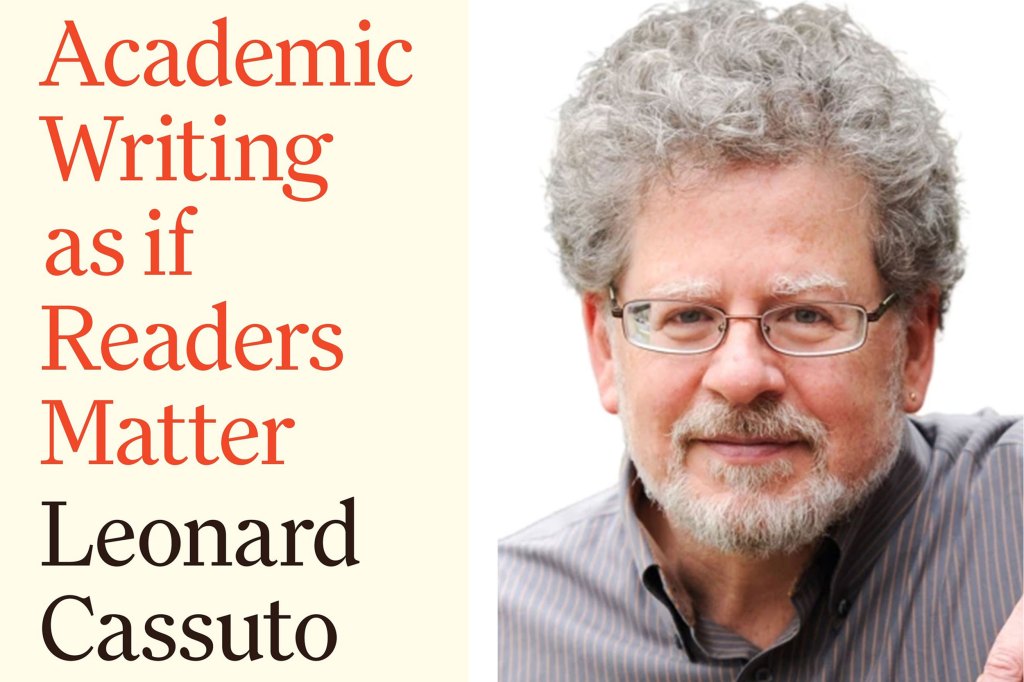
What are some of the most common pitfalls for academic writers?
Here are a few of the greatest hits: One is that too many academic writers don’t understand the importance of story. Stories are how human beings have been communicating with each other since before we could write. Human beings are storytelling animals. We are people who live by story, and every argument is a story, and every story is an argument. If academic writers are most accustomed to thinking of themselves as making arguments, then it needs to unfold in a narrative way. If it doesn’t, it’s not going to be as successful.
Then, academic writing is riddled with jargon. Jargon doesn’t have to be a bad thing; it can be an efficiency, where people are talking to other people who understand the same language. But jargon creates an in-group and an out-group, those who understand and those who do not. If your reader is not necessarily a member of that in-group, then you’re being — simply put — unfriendly. You’re saying, “I don’t really care about you.” That sort of relationship is not productive of collaboration, either in the present or in the future.
And third, too many academic writers don’t understand the necessary relationship between the abstract and the concrete. Without the concrete, the abstract is a bunch of airy-fairy ideas that are floating off in the distance. Every time the reader thinks they’ve got a grasp on them, it turns out they are wisps that drift away. But without the abstract, the concrete is just a pile of bricks, a bunch of facts that aren’t being tied together by anything. We need the abstract and the concrete to coexist. If a writer neglects this necessary connection, the chances are they’re not going to be able to be as persuasive.
You make the case that academic writing can actually be fun. How would making academic writing more fun prove a benefit to a scholar or a student?
I think that if writers remember they are people who are talking to other people, that’s the first step. There is a difference between good and bad scientific writing, and it isn’t just about questions of clarity; good science writing is also animated by sensibility. Sensibility can take many forms.
In this book I use a lot of lively metaphors. They’re designed not only to teach but to also to make the reader smile. There are different ways to communicate a sense of self or a sense of voice. The conventions of a particular discipline might dictate guidelines around that, but you can still have a voice.
Creative writing and academic writing are often seen as being at odds with one another. Can academic writing be creative?
“Creative writing” is a term of art that we use to talk about fiction, poetry, and drama, but if we think about what the words in the phrase actually mean, something that’s creative is original; it has vitality.
You can find a lot of fiction, poetry, and drama that isn’t creative by that definition, because it’s cliched, hackneyed, dead on the page. And inversely, you can find writing that is not fiction — such as academic writing — that exhibits all of these qualities that we attribute to the creative. There’s originality; there’s the vital spark, a sense of life on the page.
All writers should think of themselves as creative writers, that you’re going to do your best work if you try to create something where there wasn’t something before.
Some of these bad writing habits stem from academic anxiety or the fear the writer might be seen as “clodpoll,” as you so eloquently put it. How can writers work through that fear?
Academia as a culture promotes some bad habits of thought and being. Too many people in academia think it’s more important to show that you’re smart than it is to communicate with somebody. In fact, a writer, fearing being called “not smart,” is going to construct all kinds of defenses that inhibit understanding and communication. It tells their reader, “If you work like a sled dog, you might be able to understand it; unless you can’t, in which case, well, that’s your problem.”
I think too many academic readers have had the experience of pushing through academic writing that behaves that way. We’re not taught often enough that writing clearly and crisply is more apt to be seen as smart, more apt to gain respect — and also more likely to communicate learning.
But culture is very persistent. I understand how hard it can be to change culture, and this book is a gesture and a call for us to examine the culture in which a lot of academic writing is produced.
It’s worth noting that public awareness of A.I. — specifically, ChatGBT, which can be used for writing — burst on the scene as you were working on this book. How do you see A.I. helping or hurting academic writing?
A.I. is a tool. We have absorbed the impact of new technology before, and I think we’re going to do it again. A.I. raises legitimate concerns in many areas of our practice, but I think ultimately it will take its place in our tool kit, and we will do what we need to do in order to use it thoughtfully and productively.
I think the great fear that A.I. is going to replace us is overwrought because of the importance of sensibility. We’re still at the very beginning of learning how to use it, but I hope writers will ultimately benefit from having another tool in their kit, particularly if it can help them do their work faster.
What do you hope readers will take away from reading your book?
Writers need to communicate with a reader who is an actualperson. If we understand and appreciate that those people are out there wanting to learn from us as writers, then we can understand and anticipate their needs. We’ll produce better work. That work has a chance to be part of something bigger than us.
Academic writing is an enterprise, and each individual writer should be the best writer that they’re capable of being. We’re in this together, and we have to be able to understand that this community needs good writing in order for us to exist sustainably and productively with the larger society.
Share this article
You might like.

Some give up without guilt while others insist going cover to cover. Harvard readers share their criteria.

Novelist and boxer Laura van den Berg says the two practices have a lot in common

Alums help identify, decipher ‘one of the most significant new finds in Greek literature in this century’
What happened when a meteorite the size of four Mount Everests hit Earth?
Giant impact had silver lining for life, according to new study
How to apply cool-headed reason to red-hot topics
Michael J. Sandel brings back wildly popular ‘Justice’ course amid time of strained discourse on college campuses
Do phones belong in schools?
Banning cellphones may help protect classroom focus, but school districts need to stay mindful of students’ sense of connection, experts say.

IMAGES
COMMENTS
The basic structure of an essay always consists of an introduction, a body, and a conclusion. But for many students, the most difficult part of structuring an essay is deciding how to organize information within the body. This article provides useful templates and tips to help you outline your essay, make decisions about your structure, and ...
Essay writing process. The writing process of preparation, writing, and revisions applies to every essay or paper, but the time and effort spent on each stage depends on the type of essay.. For example, if you've been assigned a five-paragraph expository essay for a high school class, you'll probably spend the most time on the writing stage; for a college-level argumentative essay, on the ...
The basic steps for how to write an essay are: Generate ideas and pick a type of essay to write. Outline your essay paragraph by paragraph. Write a rough first draft without worrying about details like word choice or grammar. Edit your rough draft, and revise and fix the details. Review your essay for typos, mistakes, and any other problems.
Academic writing is a formal style of writing used in universities and scholarly publications. You'll encounter it in journal articles and books on academic topics, and you'll be expected to write your essays, research papers, and dissertation in academic style. Academic writing follows the same writing process as other types of texts, but ...
Indent the first line of every paragraph of text 0.5 in. using the tab key or the paragraph-formatting function of your word-processing program. Page numbers: Put a page number in the top right corner of every page, including the title page or cover page, which is page 1. Student papers do not require a running head on any page.
Step 1: Choose an Essay Topic. The first step in writing an academic essay is to choose a topic. A topic is the main idea or subject you will write about in your essay. Choose a topic that you are interested in and have a good understanding of. It should also be relevant to the course you are studying and the assignment you are working on.
Step 4: Writing the Essay Conclusion. Your essay conclusion is the final paragraph of your essay and primarily reminds your reader of your thesis. It also wraps up your essay and discusses your findings more generally. The conclusion typically makes up about 10% of the text, like the introduction.
Harvard College Writing Center 2 Tips for Reading an Assignment Prompt When you receive a paper assignment, your first step should be to read the assignment prompt carefully to make sure you understand what you are being asked to do. Sometimes your assignment will be open-ended ("write a paper about anything in the course that interests you").
Here are some key steps to writing a strong conclusion: 1. Summarize the key points. The first step in writing the conclusion is to summarize the key points of your essay. This might involve restating your research question, summarizing your findings, and reiterating your arguments. 2.
Part II: Conventions in academic writing 1. Style conventions: numbers and dates; capitals; print enhancements; abbreviations; typing and spelling 2. Tone conventions: formal, jargon and cliché-free, impersonal writing 3. Forming arguments: how to turn your information into a well-written essay or report 1. Style conventions 1.1 Numbers and dates
Strategy #1: Decompose your thesis into paragraphs. A clear, arguable thesis will tell your readers where you are going to end up, but it can also help you figure out how to get them there. Put your thesis at the top of a blank page and then make a list of the points you will need to make to argue that thesis effectively.
Table of contents. Step 1: Prewriting. Step 2: Planning and outlining. Step 3: Writing a first draft. Step 4: Redrafting and revising. Step 5: Editing and proofreading. Other interesting articles. Frequently asked questions about the writing process.
2. Define your argument. As you plan and prepare to write the essay, you must consider what your argument is going to be. This means taking an informed position or point of view on the topic presented in the question, then defining and presenting a specific argument. Consider these two argument statements:
essays—not that kind of writing. It's a how-to manual for high-quality arguments. There are four main components: - Chapters: Each provides guidance, not rules, because there are always exceptions to the rules in academic writing. - Practicums: These boxes give step-by-step instructions to help you build ideas and write papers.
Harvard College. Writing Program. roJeCT BrIeF gUIde SerIeSA Brief Guide to the Elements of the Academic Essayby Gordon HarveyGordon Harvey's "Ele. nts of the Academic Essay" provide a possible vocabulary for commenting on student writing. Instructors in Harvard College Writing Program tend to use some version of this vocabulary when ...
Academic Writing. These OWL resources will help you with the types of writing you may encounter while in college. The OWL resources range from rhetorical approaches for writing, to document organization, to sentence level work, such as clarity. For specific examples of writing assignments, please see our Common Writing Assignments area.
Strategies for Essay Writing--Complete. description. Tips for Reading an Assignment Prompt. description. Asking Analytical Questions. description. Thesis. description. Introductions. description. What Do Introductions Across the Disciplines Have in Common? description. Anatomy Of a Body Paragraph. description. Transitions.
Here are some basic rules to follow to ensure the content of your paper meets the academic writing style required by most universities. 1. Use Formal Language. X Don't use informal language. X Don't use first person narrative. Use technical terms within your field.
Table of contents. Step 1: Hook your reader. Step 2: Give background information. Step 3: Present your thesis statement. Step 4: Map your essay's structure. Step 5: Check and revise. More examples of essay introductions. Other interesting articles. Frequently asked questions about the essay introduction.
8. All paragraphs need to be relevant to the marking criteria. 9. Only include one key idea per paragraph. 10. Keep sentences short. 11. Keep quotes short. Paragraph structure is one of the most important elements of getting essay writing right.
You are trying to make it all easy to understand for your reader. The more organized your writing, the more clearly you will understand and communicate your own ideas. 5. Make your sentences work ...
Make a claim. Provide the grounds (evidence) for the claim. Explain the warrant (how the grounds support the claim) Discuss possible rebuttals to the claim, identifying the limits of the argument and showing that you have considered alternative perspectives. The Toulmin model is a common approach in academic essays.
So why is academic writing so boring? Leonard Cassuto thinks it's all a matter of keeping in mind that good writing is about keeping the reader interested. (Hint: Be a better storyteller.) Cassuto, A.M. '85, Ph.D. '89, a Fordham English professor and journalist, recently published a new book, "Academic Writing as if Readers Matter."
Table of contents. Step 1: Identify the paragraph's purpose. Step 2: Show why the paragraph is relevant. Step 3: Give evidence. Step 4: Explain or interpret the evidence. Step 5: Conclude the paragraph. Step 6: Read through the whole paragraph. When to start a new paragraph.